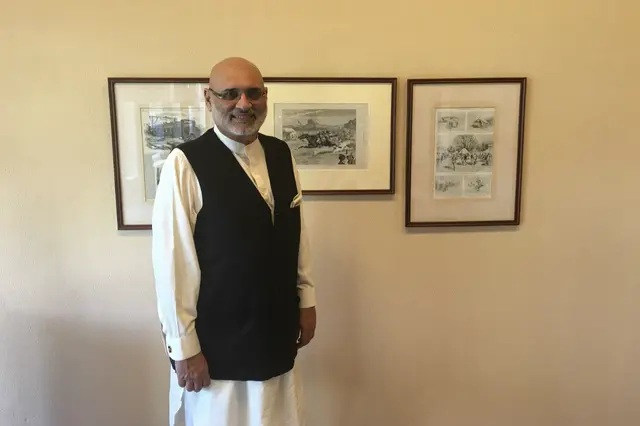Author: Nasir Ali shah Bukhari-- Chairman KASB Group of Companies, Senior Fellow of NUST GTTN
This year marks the 65th anniversary of the establishment of diplomatic relations between China and Pakistan. This modern day relationship began with Pakistan to recognize one China. Among other landmark successful achievement was setting the initial diplomatic dialogue between China and the west followed by an all-out effort of Pakistani diplomatic missions for the inclusion of China in the UN Security Council as a permanent member.
The two countries have enjoyed cordial relations in all fields since the 1950s but from times immortal the nature has engraved this relationship on stone through river Indus when it started from Lake Mansarovar in Tibet China, the Himalayan mountain range, passing through the plains of Pakistan and ending its journey in the Arabian Sea.
Chinese Ambassador to Pakistan Sun Weidong, left, and Pakistani Minister for Information, Broadcasting and National Heritage Pervaiz Rashid look at photos during a ceremony celebrating the 65th anniversary of the establishment of diplomatic relations between China and Pakistan, in Islamabad, capital of Pakistan, May 21, 2016.Photo:Xinhua
China is a rising economic power. It has taken proactive initiatives of sharing the fruits of its success with over 60 countries of Central Asia, South East Asia, West Asia, and Europe by promoting Belt and Road multi-billion dollar initiative. China is the initiator but this is not single country show. The Belt and Road are not private exclusive roads but wide and open avenues for all.Some 30 international agreements had been signed with the countries on the routes defined by China.
The Belt and Road Initiative consists of six economic collaboration routes.
The first of these corridors is the China-Russia-Mongolia route. This will help in carrying goods produced in the northern parts of China to Europe faster, than through a long sea route, if it connects to another projected corridor, the Eurasia Bridge.
Another route is the China-Central and East Asia corridor. This would help Central Asian countries find trade partners, while it will also be important in terms of the mineral richness of the region.
The projected China-Indochina Peninsula corridor offers several Chinese production centers a shortcut to the ocean, while it may also help new industries emerge on its way.
The last corridor is the India-Bangladesh-Myanmar route, for which negotiations are still underway.
But the most serious plan for Beijing to reach the ocean closer to Western maritime routes is the China-Pakistan corridor (CPEC), which is also the most mature phase of the plan. The Pakistani army is in charge of protecting the facilities. Pakistan is entering into a new phase of economic development under China-Pakistan Corridor.
CPEC is an extension of Pak-China all weather friendship. So far it includes 51 MoUs worth $46 billion. CPEC is rightly called a game-changer for Pakistan and the region. Through CPEC, China has ensured to make Pakistan, a logistic hub to connect Africa, Europe, India and Middle East with Western China and Central Asia to usher in a new economic boom for the region, thus ensuring Regional Connectivity.
Photo taken on May 21, 2016 shows gem stones displayed at a stall on the first day of Gems and Jewellery Exhibition in eastern Pakistan's Lahore. Photo: Xinhua/Sajjad
China has over US$ 5 trillion sea-borne trade that passes through the South China Sea where the Straits of Malacca is a choke point. In future, much of China’s sea-borne trade would go through Gwadar Port via land access into western China. This introduces a new dimension in China’s global trade where Pakistan would become a Suez Canal for China’s trade. “Belt and Road” countries account for more than 60 percent of the world’s population, producing more than 30 percent of the world’s merchandise trade and 30 percent of the world’s GDP.
CPEC would have indirect strategic implications as new centers of economic cooperation would emerge for the region encompassing Africa, Middle East and Central Asia. Moreover, CPEC will also give an unprecedented boost to Pak-China bilateral trade as industrial and agricultural productions would be generated inside Pakistan in 29 industrial parks and 21 processing zones all over the country during the first phase of the project.
The idea of reviving the historic Silk Road is nothing new for China, but the latest shape of the initiative mirrors Beijing’s future projections that go far beyond logistics. Goals include building an Asian bond market and improving the use of the Chinese currency, the renminbi. In areas such as finance, investment and professional technology, Pakistan can bring together the strengths of its human resource to the Belt and Road economies.
From the Lake Mansarovar to River Indus, from the Nile to the blue Mediterranean, the flowers of ancient civilizations have bloomed in the course of mutual learning and become the shared memory of countries along the routes. Through CPEC, China and Pakistan are rightfully contributing in the Community of Common Destiny for all mankind.
(APD)
 简体中文
简体中文

